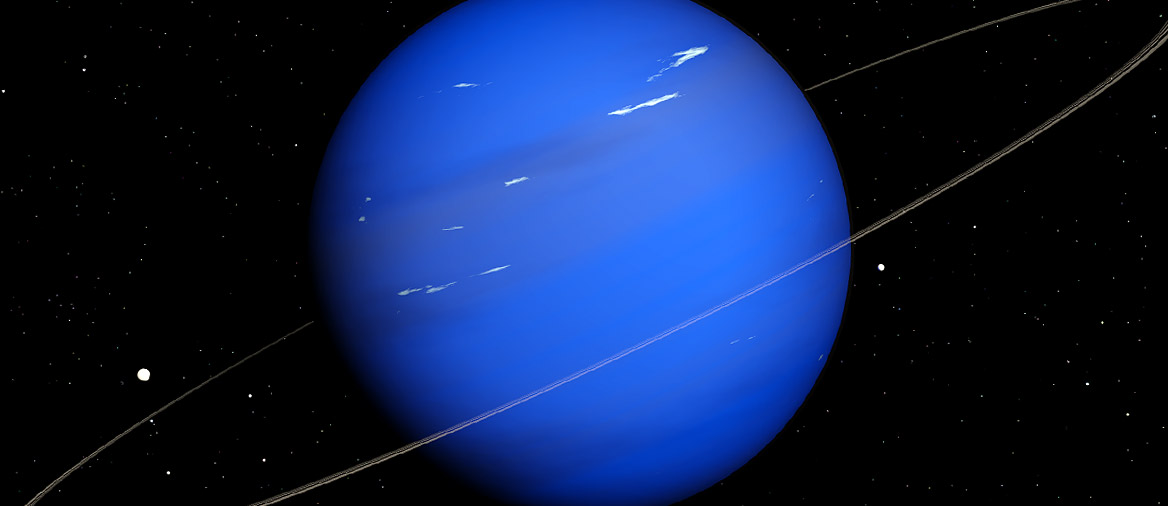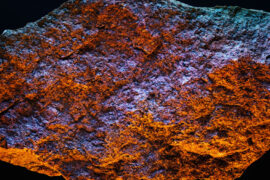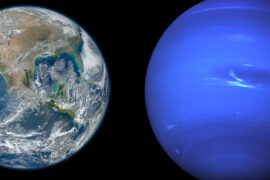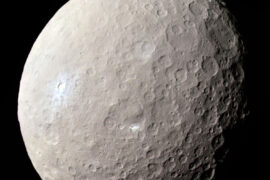Neptune is almost 35 times farther away from Earth than Mars. It is the farthest planet in the Solar system, and as a result, it is very difficult to study.
This means that Neptune is one of the planets we know the least about. This makes it really interesting because it is surrounded by mystery and questions that need an answer.
In this article, we’ll take a look at some of the unique characteristics of Neptune. The things that make it stand out and differentiate it from the rest of the planets in the Solar system.
1. Neptune is the coldest planet in the Solar system
Neptune being the farthest planet also means it is the one that receives the least amount of sunlight. As a result, Neptune is cold. In fact, it is the coldest planet in the Solar system.
The average temperature in Neptune is minus 392°F (-200°F). For comparison, the coldest place on Earth is the city of Oymyakon, in Russia, and even there the lowest temperatures recorded are “just” -58°F (-58°C).
These low temperatures are one of the main reasons why sending a probe to study Neptune is not possible as it would freeze almost immediately.
2. Neptune does not have a surface

Neptune is often referred to as an “ice giant”. But that has always seemed to me like a bad name because it makes you imagine that Neptune looks something like Antarctica or Greenland but at a greater scale. But that’s not the case. Not even close.
If you could build a ship that could withstand Neptune’s conditions and drop it onto Neptune it would sink in its clouds, and then it would keep sinking…and then it would continue to sink some more…
That is because Neptune doesn’t even have a surface to stand on. It’s all just clouds and gas until you reach its core.
The “ice” layer that scientists refer to when they call it an ice giant is really a bunch of fluids (mostly methane, ammonia, and some ice water) swirling around at high pressures and temperatures in a state that isn’t entirely liquid or solid.
3. In Neptune, it rains diamonds
Diamonds are formed when carbon atoms are exposed to very high temperatures and pressures.
Well, as mentioned in the previous point, there are layers of Neptune that meet both of those requirements. And methane has carbon (its formula is CH4). These are the perfect conditions for diamonds to form.
This is why astronomers believe that these Neptunian clouds could be diamond factories and these diamonds “rain” across the planet. The diamonds don’t fall on the surface (because there isn’t one as mentioned above). Instead, they sink through the layers of the planet until they reach regions with much higher temperatures where they evaporate.
4. Neptune also has rings like Saturn
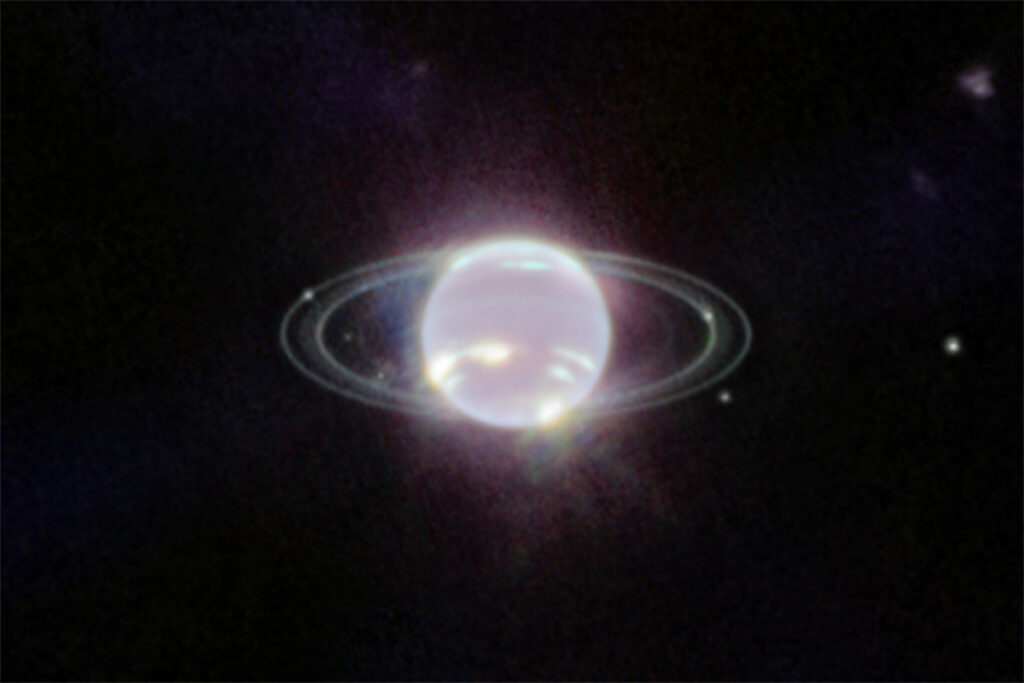
When you think about planetary rings, the first planet that comes to mind is Saturn. We can even see Saturn’s rings using a basic backyard telescope. But it turns out, it is not the only planet in the Solar system with rings. Neptune has a few too.
Neptune has five sets of rings called Galle, Le Verrier, Lassell, Arago, and Adams. These rings are very thin and their existence wasn’t confirmed until 1984 although they had been theorized ever since the discovery of the planet. Five years later, the Voyager 2 spacecraft managed to take a photo of them as it was passing by on its way out of the Solar system.
Most of Neptune’s rings are made out of billions of tiny pieces of dust. Most of them have a diameter of just a few microns.
5. Neptune wasn’t always in its current position
Astronomers believe that some of the planets in the Solar system were not formed in their current positions. Instead, the gas planets, much closer to the Sun and then migrated outward.
This movement took Neptune to the very edge of the protoplanetary disc (the cloud of dust and gas the planets formed from) where it is found today.
6. Neptune’s winds are ultrasonic
The fastest winds in the Solar system are on Neptune. On average, the speed of the Neptunian winds in the equator of the planet is 1,120 kilometers per hour (700 mph).
On the high end, the winds of Neptune have been measured at 1,900 km/h (1,200 mph).
For comparison, the most catastrophic hurricanes and tornadoes on Earth reach “only” speeds of 500 km/h (300 mph). The speed of sound on Earth is 1,235 km/h (767 mph) which means the large majority of Neptunian winds easily break the barrier of sound.
7. Neptune is as old as Earth
All the planets in the Solar system formed through “accretion” (slow accumulation due to gravity) out of the same cloud of dust and gas that was left after the formation of the Sun. We call that flat cloud a protoplanetary disc.
This means that all of the planets in the Solar system formed around the same time and has the same age. This happened somewhere between 4.5 and 4.6 billion years ago.
8. Neptune and Pluto’s orbits cross each other

Pluto is a dwarf planet located on the outer edge of the Solar system. For many decades, it was considered the ninth planet of the Solar system until the classification of “dwarf planet” was created to fit objects that did not fully meet all the characteristics of a planet.
But something very curious happens in the orbits of Pluto and Neptune. And that is that they cross each other.
So does that mean that Neptune and Pluto might collide someday?
Well, no.
The gravity of Neptune and Pluto helps solve this. Even though their orbits cross, they are never near each other because gravity has them on a very precise 3:2 pattern. That means Neptune orbits the Sun three times every time Pluto makes two orbits. Thanks to this resonance, whenever Neptune is close to the Sun, Pluto is far away from it and vice versa.
9. Neptune might have an ocean
There are places in the Solar system outside of Earth that might have liquid water. That is very exciting as water is a key component for the possibility of life to exist as we know it.
The outer layers of Neptune are too cold, as mentioned above. Any water in there would instantly become ice. However, the inner layers of Neptune are warmer. Much warmer.
Astronomers believe that in the inner layers of Neptune, there might exist regions where the temperature is just right to support liquid water. This water would stay contained without being frozen or evaporated because the dense atmosphere would create “pockets” that hold it. Of course, these pockets would be quite large so we are talking about a whole ocean existing inside them.
10. Neptune’s largest moon (Triton) might have been a planet at some point
Neptune has a total of 14 moons. But only of them is big and spherical. The rest are quite small and irregularly shaped. This moon is called Triton and it is very interesting.
Triton is the only moon in the Solar system that orbits in the opposite direction to the rotation of the planet.
This has led astronomers to believe that Triton wasn’t always a moon, but that it started out as a planetesimal, one of the early stages before a planet is formed.
Triton could have formed in the Kuiper belt, a region full of asteroids on the outer edges of the Solar system. It is believed Pluto might have also formed there.
Then, Triton might have moved inward, probably due to a collision, and was then captured by Neptune’s gravity, turning it into its moon.
This is one of the reasons why Triton isn’t in complete balance around Neptune and will “fall”, colliding with the planet.
Triton is one of the most interesting moons in the Solar system, to learn more about it check out our article on Triton facts and characteristics.

